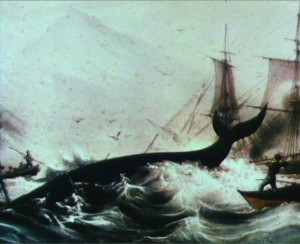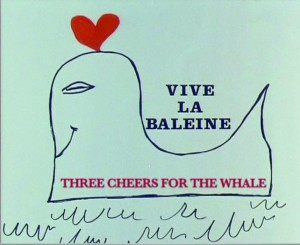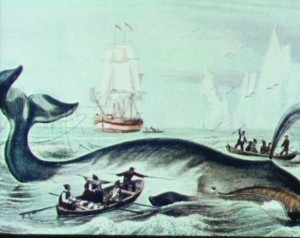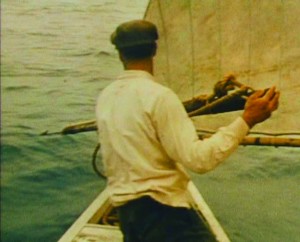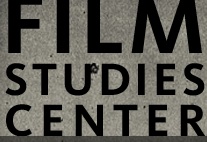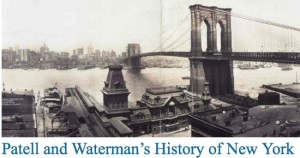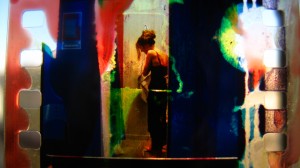Blogs and Docs interview by Pablo Marin with Lynne Sachs: http://www.blogsandocs.com/?p=216 anan
Su estilo cinematográfico, siempre en movimiento, se ubica en la encrucijada del cine documental, experimental y de ensayo autobiográfico al mismo tiempo que transciende cualquiera de estas categorías preestablecidas. Territorio estético en constante tensión, difícil de explicar con palabras, su visión creativa se expande de fotograma a fotograma como esos organismos microscópicos capaces de multiplicar su tamaño y forma en cuestión de minutos. Siempre rigurosa… siempre aleatoria. Y renovadora, claro.
Trabajando con, contra y más allá de la realidad. Una entrevista con Lynne Sachs.
A mitad de camino entre la teoría y la práctica, la obra de la cineasta, profesora, comisaria y escritora norteamericana Lynne Sachs es prácticamente única. ¿Única? Sí. Su estilo cinematográfico, siempre en movimiento, se ubica en la encrucijada del cine documental, experimental y de ensayo autobiográfico al mismo tiempo que transciende cualquiera de estas categorías preestablecidas. Territorio estético en constante tensión, difícil de explicar con palabras, su visión creativa se expande de fotograma a fotograma como esos organismos microscópicos capaces de multiplicar su tamaño y forma en cuestión de minutos. Siempre rigurosa… siempre aleatoria. Y renovadora, claro.
Durante el pasado mes de abril, Lynne Sachs visitó Buenos Aires bajo el marco de la nueva edición del Festival Internacional de Cine Independiente (Bafici 2007) para presentar tres de sus películas: Which Way is East (1994), Investigation of a Flame (2001) y States of UnBelonging (2005). Además, ofreció como actividad paralela un workshop dedicado a su obra y a los caminos paralelos del documental.
En medio de la catarata de imágenes profundamente evocativas que caracterizan su cine (esto es, en completo estado de exaltación y trance), tuve la posibilidad de charlar, junto al programador del Bafici Leandro Listorti, con una de las documentalistas más encantadoramente atípicas de los Estados Unidos.(1)
Venís presentando este workshop a lo largo del mundo, ¿cómo surgió la idea?
Lo que me atrajo de la idea de preparar una suerte de clase única fue tratar de ver la realización de trabajos que respondan a la realidad en dos maneras diferentes. Cada vez que quieres interpretar algo que sucede alrededor tuyo, lo haces desde un lugar interior y de otro exterior. Y la parte interesante es donde esos dos lugares convergen. La primera parte es aquella en la que decidí mostrar pequeños trabajos que hice que pienso que son expresiones directas de algunas observaciones muy pequeñas dotadas de una carga visual electrizante que presencié a lo largo de mi vida. Y luego esa expresión inmediata o articulación volcada hacia el cine. La segunda parte trata sobre la continuación de este interior pero sumándole el exterior. De manera que son respuestas inmediatas al mundo visible. En conjunción con nuestra manera de darnos cuenta de la dialéctica, de esas tensiones que nos rodean para mí como la intersección entre un reconocimiento personal y una conciencia más pública.
¿Cómo llegaste a la definición de que “no soy una fotógrafa de guerra”?
Surgió al darme cuenta de que había hecho varias películas que trataban el tema de la guerra, no era que no lo notara, pero en un momento lo vi más claro, en cierta manera la idea apareció como lo hizo con mi definición de que no soy agnóstica. Dando una idea de lo que no soy, creo que le doy un giro a lo que soy. De hecho el 99.9% de la gente no es un/a fotógrafo/a de guerra. Diciendo eso, estoy diciendo que soy una persona común y corriente.
Todas tus películas, incluidas esas que mostraste en el workshop, tienen una estructura muy poco rígida, casi como improvisada, ¿piensas que es posible iniciar un proyecto sin tener una idea definida?
Pienso que la mayoría de las cosas devienen de la observación. Es interesante porque he trabajado de ambas maneras. En mi película The House of Science: a museum of false facts (1991), comencé con una idea sobre mi resistencia como mujer en la manera en que la ciencia determina cómo debe ser una mujer en el mundo, y esto históricamente estuvo ligado a una percepción masculina. De manera que realicé una película desde el amor a la ciencia pero en oposición al establishment científico. Esa fue mi idea. Pero lo curioso es que también terminó siendo una de mis películas más experimentales, realizada a partir de collages, found footage y extrañas performances. Pero sí, todo partió de la base de explorar mi relación con la ciencia, específicamente en relación a los cuerpos y resultó en un cruce entre la ciencia y el arte. Por otra parte muchas de mis películas siguen un criterio del “all yes” (todo vale): cualquier idea, cualquier pensamiento, cualquier cosa que me haya ocurrido, es introducido en la película. Eso ocurre en Which Way is East, la cual comenzó sin demasiadas ideas. A diferencia de la mayoría de los cineastas norteamericanos que filmaron en Vietnam, traté de ir con la mente en blanco. De modo que es una mezcla, que comienza de cualquier manera pero rara vez parte de un guión.
En tu última película States of UnBelonging eso se refleja muy bien. Es una película situada en el medio de las ideas y lo espontáneo: comienza con un suceso histórico (el asesinato de la cineasta israelí Revital Ohavon durante un ataque terrorista a un kibbutz) pero a medida que avanza vas incorporando el proceso creativo en tiempo presente, sin eliminar ciertas fallas o dudas.
Eso no fue algo que planeé. Las dudas también son muy importantes, la mayoría de las veces sirven para que la audiencia establezca una conexión con la película, para que se adapte. Ken Jacobs es un cineasta que siempre me inspiró con su teoría de que hacemos un cine “de errores”. Pero no es tanto como querer filmar con cierto nivel de exposición de luz y que no salga de esa manera: es pensar que si el sonido no salió significa que no quería salir de esa manera. Es algo más espiritual. Es tratar de tener una naturaleza menos controladora. En cierta forma es como decía Jonas Mekas, “hacemos films del color de la sangre”. Y no es que queramos hacer películas con sangre, sino tener una relación corpórea con el material.

